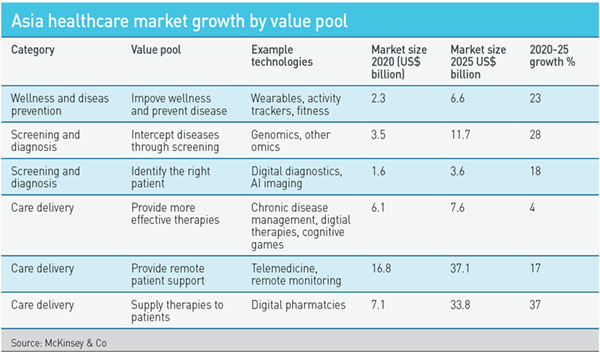
2022 preview: Healthcare

Healthcare’s high-cost, rapidly digitizing profile will persist regardless of how COVID-19 plays out in the coming years. China appears set for consolidation, including in biotech
The market in Asia for genomics related to disease screening will grow 28% between 2020 and 2025 to $11.7 billion, according to McKinsey & Company. During the same period, Asian digital pharmacies will surge 37% to $33.8 billion, while telemedicine in the region bounces 17% to $37.1 billion. Unfortunately, the industry's financial upside is a symptom of its inadequacy helping people.
"A billion people will die in Asia without ever seeing a doctor – not at birth, while they're alive, or when they die," says Abrar Mir, a co-founder and managing partner at Quadria Capital. "Investment in healthcare is accelerating due to the secular growth opportunity. But the quantum of investment still isn't enough, and the gap between demand and supply continues to widen."
The urgency to fill this hole is still a bigger driver of healthcare digitalization than social distancing norms and heightened health awareness related to COVID-19. This is worth bearing in mind in 2022 and 2023 because although the dislocations of the pandemic will become imperceptible, valuations will continue to climb.
The thinking here is that healthcare in Asia – and especially health-tech – will continue to experience a rare "goldilocks" balance of minimal downside and strong growth during this period.
Volatility in valuations will be limited by the fact that they are not supported by monetary policy, and upside will be bolstered by the fundamentals of the service gap. Where macro growth floats all boats, investors will need to prioritize company-level execution capability in their due diligence.
Best-practice policies on these points will have to become more widespread as the flood of capital continues to expand. PE and VC investment in healthcare across the region in 2021 to date amounts to $31.59 billion, on par with 2020's record $31.6 billion, according to AVCJ Research. The average was $13.9 billion a year during the five years before that.

Changes in patient behavior remain the guiding star in terms of deal targeting. Telemedicine will be dominant but other software-enabled areas will expand as well, including artificial intelligence-enabled diagnostics and software-as-a-service for hospitals.
Private equity operators will begin making investments in this space. For specialist investors, this activity may be prefaced by partnerships, whereby a tech start-up seeks to gain access to a GP's portfolio of traditional institutions.
Following patient behavior is not necessarily digital business, however. Quadria predicts at-home healthcare will be a massive growth area; it invested $40 million in India's Health Care At Home in 2017. A growing population of devices companies and infrastructure providers geared toward getting doctors and nurses into remote communities evidences the outlook.
"At-home healthcare will no longer be just primary care: like wound care, diabetes care or delivering medicine," Mir says. "It will include critical care, from intensive care at home to even dialysis and chemotherapy in the home. It's a profound trend, which is led by patient behavior and accelerated by technology. It has the potential to revolutionize not only how primary care but also how acute care is delivered."
Things will play out differently in China, where policy has had a much stronger influence on valuations and segment development. The biggest push here is to control costs and cut out supply chain intermediaries as the overall patient burden builds.
A fragmented sector of 5,000 pharmaceuticals companies and 10,000 devices companies will have varying levels of success adapting to the new market conditions. In some cases, first-generation founders will have to consider difficult succession issues while balancing unfamiliar management control obligations. For others, the new dynamics could require more investment in R&D or a pivot in operations.
GL Capital, which became one of the first buyout players in China healthcare in 2010, sees this backdrop as a recipe for accelerated consolidation and control investment next year. The opportunity could extend to the biotech space, where a recent surge in domestic innovation success is said to have devolved into a shark tank of copycat offerings and unjustified valuations.
"The money flowing into biotech is definitely propelling more innovation, which is good for the development of the industry. But when it becomes overinvested, the innovation competency is not truly built up yet, and it turns into a race to get to the capital markets, we end up with too many me-too products resulting in wasted resources and inefficiency in innovation," says Shirley Lin, a managing director at GL.
"Regulators are also addressing this issue, and we're starting to see a correction of valuations. That will prompt some biotech companies, especially the smaller ones, to sell their platforms and consolidate."
Latest News
Asian GPs slow implementation of ESG policies - survey
Asia-based private equity firms are assigning more dedicated resources to environment, social, and governance (ESG) programmes, but policy changes have slowed in the past 12 months, in part due to concerns raised internally and by LPs, according to a...
Singapore fintech start-up LXA gets $10m seed round
New Enterprise Associates (NEA) has led a USD 10m seed round for Singapore’s LXA, a financial technology start-up launched by a former Asia senior executive at The Blackstone Group.
India's InCred announces $60m round, claims unicorn status
Indian non-bank lender InCred Financial Services said it has received INR 5bn (USD 60m) at a valuation of at least USD 1bn from unnamed investors including “a global private equity fund.”
Insight leads $50m round for Australia's Roller
Insight Partners has led a USD 50m round for Australia’s Roller, a venue management software provider specializing in family fun parks.








